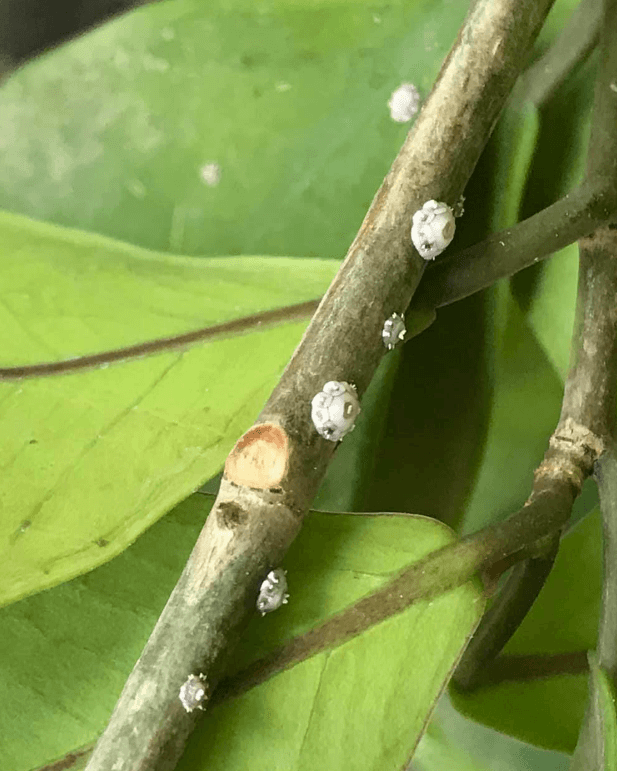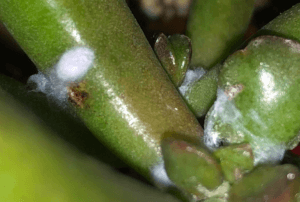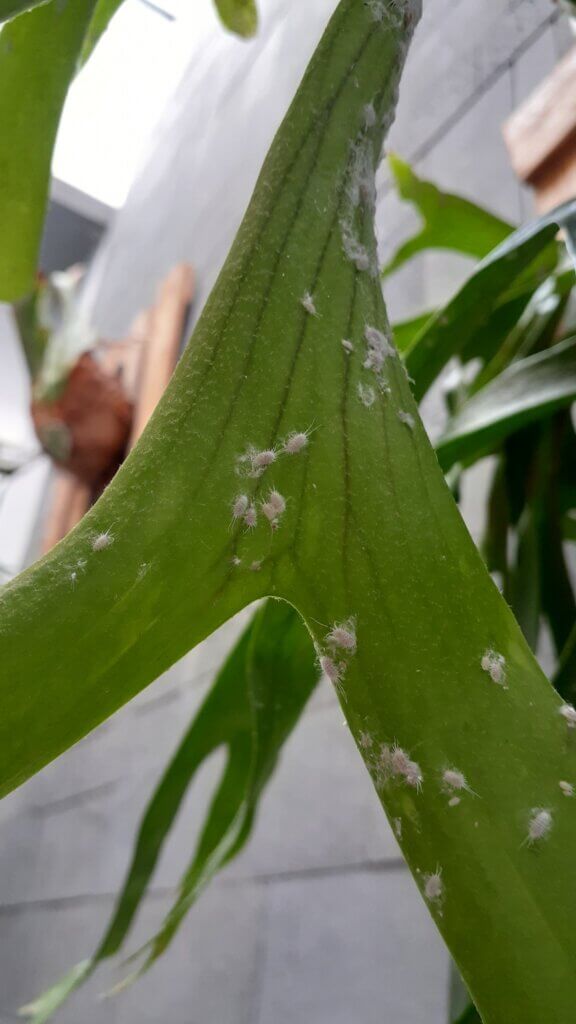Battling a mealybug invasion in your semi-hydroponic system? Fear not! In this guide, I’ll walk you through a simple yet effective process to rid your indoor plants of mealy bugs for good. Understanding these pests’ life cycle and timely treatment is key to success.
Read on to discover how to tackle mealy bugs in your semi-hydroponic setup.
Understanding Mealybugs
Mealybugs are soft-bodied insects that can be a nightmare for plant enthusiasts. Resembling tiny cottony clusters, they’re about 1/8″ in size.
These pests wreak havoc by sapping essential juices from your plants’ leaves, especially problematic in semi-hydroponic systems like LECA or Lechuza Pon where plants are more sensitive to such infestations.
These bugs are notorious for secreting a sticky substance known as honeydew. This leads to the growth of sooty mold, which, while not directly harmful to plants, can hinder their ability to photosynthesize if it spreads extensively.
Catching an infestation early is crucial.
Female mealybugs are prolific, capable of laying 300 to 600 eggs, and then they perish. The longtailed mealybug, a different species, reproduces by giving birth to live young.
Depending on the species and your growing conditions, their life cycle may span six weeks to two months, a period during which your semi-hydroponic plants can suffer significant damage.

Effective Mealybug Treatment for Semi-Hydroponic Plants
When dealing with mealybugs, the first step is isolation. Separate the affected plants from your healthy ones to prevent the infestation from spreading.
Ideally, place your infested plants in a different room, away from any other plants, especially crucial in semi-hydroponic setups where plants are often in close proximity.
Thorough Plant Cleansing
Mealybugs can wreak havoc on your plant collection, particularly in semi-hydroponic systems like LECA or Lechuza Pon, where the impact can be more severe. Tackling a heavy infestation early is vital.
Begin by choosing an effective treatment: insecticidal soap, horticultural oil, or 70% isopropyl alcohol.
You can also use neem oil (which is better for spider mites) but it’s not recommended against Mealybugs due to its less effective and unpleasant odor, particularly in enclosed or poorly ventilated areas common in indoor semi-hydroponic setups.
For visible mealybugs, dabbing them with a cotton swab or ball soaked in alcohol will kill them on contact. However, this method alone isn’t enough. Mealybugs at different life stages may be hidden, so targeting only the visible ones won’t eradicate the problem.
Spray the affected plant thoroughly with your chosen solution.
It’s critical to cover every part of the plant, including the undersides of leaves. If your semi-hydroponic system allows, remove the plant from the setup to ensure complete coverage without damaging the system.
After treatment, keep the plant out of direct sunlight to prevent leaf burn while it’s still wet.
Non-Pesticide Options:
- Rubbing Alcohol: Effective for small infestations, rubbing alcohol can be applied directly to mealybugs using a cotton swab. Alternatively, dilute it to 25%-50% and use as a spray, after testing on a small plant area to avoid leaf burn. Alcohol works only on contact and has no lasting effect.
- Insecticidal Soap: This option also kills pests on contact without residual action. It’s generally less effective than alcohol.
Insecticides:
- Bifenthrin: A synthetic pyrethroid, Bifenthrin effectively controls a wide range of pests, including termites and spiders. It’s excellent for most common pests and can suppress spider mites. Bifenthrin is also useful as a barrier spray around homes. It’s cost-effective.
- Permethrin: Another synthetic pyrethroid, Permethrin is effective against a narrower range of pests. It’s an active ingredient in dog flea collars and human lice treatments but is toxic to cats, so ensure they avoid treated areas until dry (about 12 hours). Available at home improvement stores as Bonide Eight in a 32oz bottle for around $20.
- Imidacloprid: A highly effective pesticide, Imidacloprid belongs to the neonicotinoid class. Despite its global usage, it’s banned in the EU due to its impact on bees. It’s safe and efficient for greenhouse or indoor plants, which don’t harm bees. Avoid using it on outdoor flowering plants within three months. Ideal for preventing soil-borne pests like thrips, fungus gnats, and mealybugs, it lasts 90 days per application. Applied via soil, it’s not instant and better for prevention than treating severe infestations. Available on Amazon as Bonide Systemic Houseplant Insect Control (8oz for about $20). For those with many plants, consider Marathon, which is pricier initially but more economical per use (5lb container for $80, 1% concentration compared to Bonide’s 0.22%).
Integrate Systemic Insecticide
For a more comprehensive approach in semi-hydroponic systems, consider using a systemic insecticide alongside spraying.
A product like Bonide Houseplant Systemic Insect Control, when applied as per instructions, becomes absorbed by the plant. This internal protection lasts up to 8 weeks, safeguarding your plant from the inside out. This two-pronged strategy (spraying and systemic treatment) is crucial to overcome a mealybug infestation effectively.
While some might suggest using a homemade soapy solution, I advise against it.
Many plants, particularly those in semi-hydroponic systems, have delicate waxy leaf coatings that can be damaged by the ingredients in household soaps.
Instead, opt for a pre-formulated insecticidal soap.
It’s also worth noting that root mealybugs, which reside in the root system and are typically unnoticed until repotting, can be effectively targeted by Bonide Houseplant Systemic Insect Control.
Maintain Consistent Spraying Schedule
The key to successful treatment lies in persistence. Continue spraying your infested plants weekly for two months. Each application will progressively reduce the mealybug population. Although this might seem excessive, it’s necessary to ensure complete eradication.
Remember, mealybugs can be elusive, hiding in egg sacs, as nymphs, or as adults in various plant parts. Therefore, a thorough weekly spray for about two months is crucial, especially in cases of severe infestation.
Additionally, consider rinsing your plants with plain water every couple of weeks, after the insecticidal soap has dried, to help remove any residual pests or eggs.
Post-treatment, it’s important to regularly check your plants for any signs of mealybug resurgence. Diligence in following these steps should resolve your mealybug issue effectively.
Lifecycle and Behavior of Mealybugs

Understanding the Lifecycle
Mealybugs, a common pest in both soil and semi-hydroponic systems, have a lifecycle comprising three main stages: egg, nymph, and adult.
Female mealybugs lay hundreds of eggs, often in a cottony egg sac. These eggs hatch into nymphs, which are mobile and spread quickly across the plant, especially in the confined spaces of semi-hydroponic systems.
As adults, they attach to plant parts and feed by sucking sap, weakening the plant. The complete cycle can take about one to two months, depending on environmental conditions.
Behavior in Semi-Hydroponics
In semi-hydroponic systems, mealybugs tend to hide in the crevices of growing mediums like LECA, Pumice or Pon, making them harder to detect and eradicate.
Their preference for moist environments makes semi-hydroponic setups particularly vulnerable to infestations.
Understanding this behavior is crucial for effective treatment and prevention strategies.
Identification Guide
Visual Identification Mealybugs are small (about 1/8 inch), soft-bodied insects covered with a white, waxy, cotton-like substance. In semi-hydroponic systems, they are often found in clusters hidden under leaves, near stem joints, or within the crevices of the growing medium.

Signs of Infestation
- Presence of white, cottony masses on plants.
- Yellowing or wilting of leaves, indicating nutrient and sap loss.
- Sticky residue (honeydew) on leaves or nearby surfaces, which may lead to sooty mold.
- In semi-hydroponic systems, check for unusual spots on roots or within the medium itself, as mealybugs can also infest these areas.
Impact on Plant Health
Direct Damage
Mealybugs feed by inserting their long mouthparts into plant tissues and sapping essential nutrients. This feeding can lead to stunted growth, yellowing or wilting of leaves, and, in severe cases, plant death. The impact is often more pronounced in semi-hydroponic systems due to the close proximity of plants and shared resources.
Secondary Issues
The honeydew excreted by mealybugs can attract other pests and lead to the development of sooty mold, which further hampers photosynthesis. In semi-hydroponic systems, this can also lead to the development of fungal and bacterial issues due to increased humidity and moisture.
Long-Term Effects
If not addressed, a mealybug infestation can weaken plants, making them more susceptible to other pests and diseases. Chronic infestations can significantly reduce the aesthetic and health of the plant, and in semi-hydroponic systems, the problem can rapidly spread to other plants.



